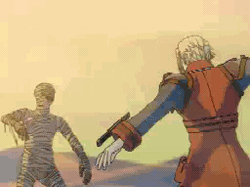 Castlevania games are traditionally divided into two camps: Before Koji Igarashi and After Koji Igarashi. The BI period featured games that were straightforward, level based affairs. Double murder the legions of the undead, skip over a few bottomless pits, and then preserve your last sliver of health to crush whatever Universal Movie Monster has decided to become the boss. Repeat for five to fifteen levels, and then cross the finish line by exposing Dracula to a dazzling new dawn. Meanwhile, the AI period brought forth the eponymous Metroidvania concept: here’s a big giant castle, now explore around, find some new skills and treasures, and eventually turn your digital avatar into a particularly nimble tank on the way to show Dracula who’s boss. Available in one castle or two.
Castlevania games are traditionally divided into two camps: Before Koji Igarashi and After Koji Igarashi. The BI period featured games that were straightforward, level based affairs. Double murder the legions of the undead, skip over a few bottomless pits, and then preserve your last sliver of health to crush whatever Universal Movie Monster has decided to become the boss. Repeat for five to fifteen levels, and then cross the finish line by exposing Dracula to a dazzling new dawn. Meanwhile, the AI period brought forth the eponymous Metroidvania concept: here’s a big giant castle, now explore around, find some new skills and treasures, and eventually turn your digital avatar into a particularly nimble tank on the way to show Dracula who’s boss. Available in one castle or two.
So Koji Igarashi is, for better or worse, hailed as changing Castlevania forever, but almost exclusively for the changes to the gameplay of the series. However, whether he be the source or merely there at the turning point, no one ever takes the time to examine how Castlevania’s characterization changed at the exact same point.
The Castlevania series is fairly unique for a “retro” game series. Mega Man games star Mega Man, the Super Mario Bros. franchise stars Mario and, in some extremely rare cases, maybe Luigi or Princess Peach, both characters that were established as of Super Mario Bros. 1. Sonic the Hedgehog has had such disastrous times with Shadow at the helm that Sonic now has to dress up in silly period costumes to headline spinoffs. To be clear, I’m not faulting any of these games for sticking to their stars, as, honestly, it’s just good branding: you can stick Peter, Miles, or Doc Ock in the Spider-Man costume, but you better make sure that iconic red and blue is on the cover before you send it to press. Meanwhile, in Castlevania land (Wallachia?), Simon Belmont, star of Castlevania I, Castlevania II, and Captain N: The Game Master, couldn’t even be bothered to round out the initial trilogy, so ancestor Trevor Belmont took up the whip. Simon returned for the next console release, and then ducked out again so a pair of newbies could hit the Genesis, and a random descendant took up the torch on the SNES. All the while, Mario’s only change across a myriad of releases was occasionally regressing to infancy. Working for Konami is pretty rough, even on the mascots.
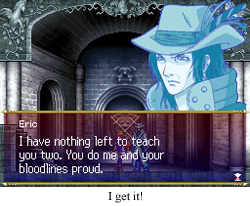 While Simon Belmont would always be the most popular face of the series, Castlevania games continually invented new heroes to fit new time periods. Before anyone claims that this is just a necessary evil of even having Dracula transcend epochs, remember that Castlevania is published on the same Earth as The Legend of Zelda, a series where a very similarly dressed series of elves seem to pop up every century or so to combat the same eternal villain. There’s really no reason Simon Belmont couldn’t generically resurrect to match his hated enemy. And that thought comes to mind immediately when you examine Simon’s ancestors and descendants. Simon Belmont is a generally burly fellow who stalks evil with a whip. Trevor Belmont of Castlevania 3 is a generally burly fellow who stalks evil with a whip. Richter Belmont of Castlevania Dracula X is a generally burly fellow who is engaged to be married and stalks evil with a whip. Christopher Belmont of Castlevania Adventures is a generally burly fellow with a son and stalks evil with a whip. John Morris of Castlevania Bloodlines is a generally burly fellow who stalks evil with a whip.
While Simon Belmont would always be the most popular face of the series, Castlevania games continually invented new heroes to fit new time periods. Before anyone claims that this is just a necessary evil of even having Dracula transcend epochs, remember that Castlevania is published on the same Earth as The Legend of Zelda, a series where a very similarly dressed series of elves seem to pop up every century or so to combat the same eternal villain. There’s really no reason Simon Belmont couldn’t generically resurrect to match his hated enemy. And that thought comes to mind immediately when you examine Simon’s ancestors and descendants. Simon Belmont is a generally burly fellow who stalks evil with a whip. Trevor Belmont of Castlevania 3 is a generally burly fellow who stalks evil with a whip. Richter Belmont of Castlevania Dracula X is a generally burly fellow who is engaged to be married and stalks evil with a whip. Christopher Belmont of Castlevania Adventures is a generally burly fellow with a son and stalks evil with a whip. John Morris of Castlevania Bloodlines is a generally burly fellow who stalks evil with a whip.
Are you seeing something of a pattern here? Whether it was Simon or Trevor or John, the BI protagonists of Castlevania were basically interchangeable. They were all Belmonts, more or less, and there was really no reason to have anybody but Simon, because they basically all were Simon.
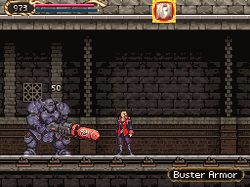 Iga’s premiere, Castlevania: Symphony of the Night, radically changed the formula by focusing on a Belmont’s supporting cast member. Alucard, star of Symphony of the Night, had previously appeared in Castlevania 3 as one of Trevor’s possible traveling companions, along with Sypha and Grant DaSuppaNasty. Castlevania games had a tendency toward supporting casts, but the best way to summarize their involvement is likely to just point out that a lot of people played the hell out of Castlevania 3 and were never even aware of Sypha’s gender. What about Grant? What are Grant’s hopes and fears? What specifically happened to his family and his people? Why did he take shelter in a clock tower? Is he at all embarrassed climbing around like a common simian? Castlevania 3 doesn’t care to answer these questions, and stop being introspective, these skeletons aren’t going to whip themselves.
Iga’s premiere, Castlevania: Symphony of the Night, radically changed the formula by focusing on a Belmont’s supporting cast member. Alucard, star of Symphony of the Night, had previously appeared in Castlevania 3 as one of Trevor’s possible traveling companions, along with Sypha and Grant DaSuppaNasty. Castlevania games had a tendency toward supporting casts, but the best way to summarize their involvement is likely to just point out that a lot of people played the hell out of Castlevania 3 and were never even aware of Sypha’s gender. What about Grant? What are Grant’s hopes and fears? What specifically happened to his family and his people? Why did he take shelter in a clock tower? Is he at all embarrassed climbing around like a common simian? Castlevania 3 doesn’t care to answer these questions, and stop being introspective, these skeletons aren’t going to whip themselves.
Alucard could easily have been yet another burly tabula rasa of a protagonist, but time was taken to establish Alucard, not only through his interaction with other castle denizens, but also through a very revelatory flashback that is weaved right into the gameplay. The succubus is a boss fight and character development! Wow! It’s not exactly Dickens, but ask yourself this: name a single mother in all of Castlevania prior to Symphony of the Night. Hell, give me a single named female you’re not either playing as, against, or rescuing that actually appears in game. Any non-Maria ladies in Rondo of Blood were practically indistinguishable from the items that allowed you to find them…
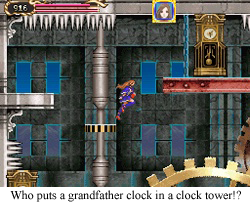 Alucard is fondly remembered by the Castlevania fanbase, and it can’t just be because his solo adventure was one of the greatest games to grace the Playstation. Alucard made a lasting impression over the hordes of Belmonts because he was actually developed as a character, and, whether the player consciously acknowledged it or not, it made an impact on his legacy. And the kick of it? Iga could easily have used Alucard for every successive Castlevania. Nobody would complain about how Alucard is still alive centuries later. He’s an immortal halsfy vampire with an Oedipus complex; you could hang an entire young adult heptalogy on that concept alone.
Alucard is fondly remembered by the Castlevania fanbase, and it can’t just be because his solo adventure was one of the greatest games to grace the Playstation. Alucard made a lasting impression over the hordes of Belmonts because he was actually developed as a character, and, whether the player consciously acknowledged it or not, it made an impact on his legacy. And the kick of it? Iga could easily have used Alucard for every successive Castlevania. Nobody would complain about how Alucard is still alive centuries later. He’s an immortal halsfy vampire with an Oedipus complex; you could hang an entire young adult heptalogy on that concept alone.
But, no, the following Castlevania games in the Iga line all featured entirely new protagonists, just like the Castlevania games of his ancestors. In this time we saw things like the full origin of the Vampire Killer and the Belmont line, some random dork trying to find the latest Maxim or something, and Soma, a simple high school student who just happened to be the reincarnation of Dracula. Technically, all of these stories could have been told in the dark ages of Castlevania, but what’s important is that all of these games feature “stories” as well as excellent gameplay, something that the BI Castlevanias abandoned right around the time you put down the manual for the Belmont’s latest adventure.
Castlevania: Portrait of Ruin is not the best Castlevania ever made. It was created late in Iga’s Metroidvania portable period, and, honestly, even at the time, it felt like about the 6,000th game with the exact same setup and gameplay. It’s even the “middle child” of the DS games, featuring neither the “refined soul system” of Castlevania: Dawn of Sorrow nor the fairly experimental, vaguely level based setup of Order of Ecclesia. Portait of Ruin tried a few new things with dual characters available simultaneously and “separate castles” hidden in paintings, but it all feels like very well-worn territory, and it’s territory that was better explored in previous installments.
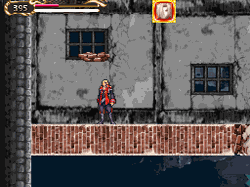 But Portrait of Ruin has a whole lot of heart (and not just hidden in candelabras). Jonathan Morris, our Belmont du jour (mostly), and precocious witch Charlotte Aulin are the dual heroes of the piece, and their interactions and general personality uplift a potentially dour quest through a castle of undeath. Eric Lecarde of Castlevania Bloodlines returns as a dead man who gets far more character development than he ever did while breathing. Stella and Loretta are delightfully malicious vampires for the majority of the piece, and pleasantly remind me most of Buffy the Vampire Slayer style “quippy sadist” vamps. Victor Brauner isn’t much of a villain by comparison, but he does get bonus points for being based on a real guy. It’s a cast of, basically, six people, but it’s amazing how such a small ensemble can be memorable and meaningful. Jonathan and Charlotte both grow over the course of their adventure, not only through acquiring skills and vanquishing chimeras, but also through acquiring understanding and vanquishing daddy issues. Once again, it ain’t Hemmingway, but it does enhance what could easily be a rote affair.
But Portrait of Ruin has a whole lot of heart (and not just hidden in candelabras). Jonathan Morris, our Belmont du jour (mostly), and precocious witch Charlotte Aulin are the dual heroes of the piece, and their interactions and general personality uplift a potentially dour quest through a castle of undeath. Eric Lecarde of Castlevania Bloodlines returns as a dead man who gets far more character development than he ever did while breathing. Stella and Loretta are delightfully malicious vampires for the majority of the piece, and pleasantly remind me most of Buffy the Vampire Slayer style “quippy sadist” vamps. Victor Brauner isn’t much of a villain by comparison, but he does get bonus points for being based on a real guy. It’s a cast of, basically, six people, but it’s amazing how such a small ensemble can be memorable and meaningful. Jonathan and Charlotte both grow over the course of their adventure, not only through acquiring skills and vanquishing chimeras, but also through acquiring understanding and vanquishing daddy issues. Once again, it ain’t Hemmingway, but it does enhance what could easily be a rote affair.
As I write this piece, Iga has recently kickstarted his newest venture, Bloodstained: Ritual of the Night. The unspoken promise of this project is that Koji Igarashi is back, and he’s bringing back that sweet Metroidvania gameplay you know and love, just with the Castlevania branding filed off. Needless to say, I forked over the dough to support such a thing as quickly as possible, but I have to say, there’s a part of me that’s a little sad that Iga won’t be touching the Castlevania franchise again. Yes, he’ll go on to create new characters just as memorable as Jonathan and Charlotte, but without that special touch for characterization, the Belmonts are already regressing to “strong guy, annoyed about something, has a whip”. Do I even need to note the current state of “Alucard”? Everyone may remember the dimensions of gameplay Iga brought to the franchise, but I’m going to ignore the minimaps and double jumps and armor upgrades and remember the people that we’ll never see again.
RIP Jonathan and Charlotte, may you one day be undead.
FGC #28 Castlevania: Portrait of Ruin
- System: Nintendo DS
- Number of Players: 2, actually, if we’re including the boss rush. Which we are, because it seems like I only ever play one player games, and I crave phony variety.
- Favorite Character: Charlotte is such a breath of fresh air compared to the typical warrior that is usually exploring Castlevania. I can’t help but feel like I’m not the only one that noticed this, as the following game starred a lady combat mage. Way to strike against the malecentric manocracy, Charlotte!
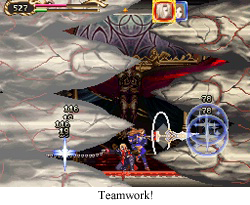 Favorite Spell: And I would be remiss if I didn’t note that turning into an owl is a thousand times better than turning into a bat. It’s the little things in life that matter.
Favorite Spell: And I would be remiss if I didn’t note that turning into an owl is a thousand times better than turning into a bat. It’s the little things in life that matter.- Favorite Boss: This normally isn’t the case, but the absolute final boss of the game is my favorite here. Dracula pulls out a few new tricks with his super best bro and it really reinvigorates a tired old trope. Brauner gets second place for playing with paint in interesting ways.
- Did you know? Richter and Maria of Rondo of Blood are available as special bonus characters. As an odd quirk of localization, this is the first time Maria was available as a playable character in North America. Doesn’t seem right, but there it is.
- Would I play again? Every once in a while, I get the urge to replay approximately every Iga Castlevania, and it certainly helps that the 3DS plays DS games. So, yeah, it’s not a matter of “if” but “when”.
What’s next? Random ROB has chosen…. Hyrule Warriors for the WiiU. Wow, is that our most recently released ROB chosen game? I… think so. I should really be keeping a list here… Anyway, please look forward to it!
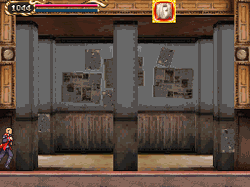

[…] talk about what came after Castlevania: Aria of Sorrow. Castlevania: Portrait of Ruin is an Igavania… but it seems much more “level based” with its multiple portrait stages and a […]
[…] an easel always means at least one mandatory, difficult boss fight in your near future, every portrait of ruin also means a mini-dungeon where there are plenty of powerups and two new abilities to sus out. So, […]
[…] provocation. And, honestly, I am completely incapable of interpreting any of the “IGAvania” Castlevania games as bad in any plausible way. However, the recent glut of “indie” metroidvania games has proven […]
[…] “one big castle/planet” of most metroidvanias. But it could still work! Order of Ecclesia and Portrait of Ruin both had “level” like areas, so it’s not completely alien to the genre. Oh! And the […]